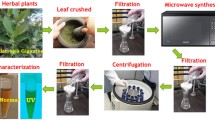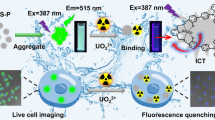Abstract
Hypochlorous acid (HClO), a highly reactive oxygen species, has important effects on human health. High selectivity and sensitivity remain challenges of fluorescent probes for detection of ClO− with a large Stokes shift. This work designed and synthesized a novel phenothiazine-based fluorescent probe TF which can detect ClO− by colorimetric and fluorescent dual signals. TF displayed turn-on fluorescence effect toward ClO− with high selectivity (≥ 28-folds) and sensitivity (LOD = 0.472 μM), fast response time (< 1 min) and large Stokes shift (150 nm) in PBS (pH = 7.4, 40% DMSO). Meanwhile, TF can visualize ClO− on the mung bean sprouts model and apply as testing strips for portable and rapid detecting ClO− by the naked eyes.
Graphical Abstract
A phenothiazine-based fluorescent probe with large Stokes shift was synthesized and its responding rapidly ability to detect ClO− was studied.








Similar content being viewed by others
Data Availability
Not applicable.
References
Wang HS (2016) Development of fluorescent and luminescent probes for reactive oxygen species. TrAC Trends in Anal Chem 85:181–202. https://doi.org/10.1016/j.trac.2016.09.006
Ma H, Chen KW, Song B, Tang ZX, Huang YD, Zhang T, Wang HN, Sun WP, Yuan JL (2020) A visible-light-excitable mitochondria-targeted europium complex probe for hypochlorous acid and its application to time-gated luminescence bioimaging. Biosens Bioelectron 168:112560. https://doi.org/10.1016/j.bios.2020.112560
Hou JT, Kwon N, Wang S, Wang BY, He XJ, Yoon J (2022) Sulfur-based fluorescent probes for HOCl: Mechanisms, design, and applications. Coordin Chem Rev 450:214232. https://doi.org/10.1016/j.ccr.2021.214232
Winterbourn CC, Hampton MB, Livesey JH, Kettle AJ (2006) Modeling the reactions of superoxide and myeloperoxidase in the neutrophil phagosome: implications for microbial killing. J Biol Chem 281:39860–39883. https://doi.org/10.1074/jbc.M605898200
Feng H, Zhang ZQ, Meng QT, Jia HM, Wang Y, Zhang R (2018) Rapid Response Fluorescence Probe Enabled In Vivo Diagnosis and Assessing Treatment Response of Hypochlorous Acid-Mediated Rheumatoid Arthritis. Adv Sci 5:1800397–1800406. https://doi.org/10.1002/advs.201800397
Yang J, Zhang XL, Yuan P, Ran CZ (2017) Oxalate-curcumin-based probe for micro- and macroimaging of reactive oxygen species in Alzheimer’s disease. Proc Natl Acad Sci 114:12384–12389. https://doi.org/10.1073/pnas.1706248114
Hoozemans JJ, Scheper W (2012) Endoplasmic reticulum: the unfolded protein response is tangled in neurodegeneration. Int J Biochem Cell Biol 44:1295–1298. https://doi.org/10.1016/j.biocel.2012.04.023
Jeitner TM, Xu H, Gibson GE, Neurochem J (2005) Inhibition of the alpha-ketoglutarate dehydrogenase complex by the myeloperoxidase products, hypochlorous acid and mono-N-chloramine. J Neurochem 92:302–310. https://doi.org/10.1111/j.1471-4159.2004.02868.x
Wu P, Zhu Y, Chen LL, Tian Y, Xiong H (2021) A Fast-Responsive OFF-ON Near-Infrared-II Fluorescent Probe for In Vivo Detection of Hypochlorous Acid in Rheumatoid Arthritis. Anal Chem 93:13014–13021. https://doi.org/10.1021/acs.analchem.1c02831
Zhou BX, Han YL, Liu JY, Cheng K, Dong MD, Tang X (2023) Design and Synthesis of Novel Fluorescent Probe Based on Cyanobiphenyl and its Application in Detection of Hypochlorite. J Fluoresc 33:575–586. https://doi.org/10.1007/s10895-022-03094-y
Liu SZ, Xu JH, Ma QJ, Wang BY, Li LK, Zhu NN, Liu SY, Wang GG (2023) A naphthalimide-based and Golgi-targetable fluorescence probe for quantifying hypochlorous acid. Spectrochim Acta A 286:121986. https://doi.org/10.1016/j.saa.2022.121986
Xu ZC, Wang XF, Duan TT, He R, Wang FW, Zhou XJ (2021) Development of an ultrafast fluorescent probe for specific recognition of hypochlorous acid and its application in live cells. RSC Adv 11:24669–24672. https://doi.org/10.1039/d1ra04082k
Zeng XD, Chen J, Yu SH, Liu ZG, Ma MS (2022) The Development of a 4-aminonaphthalimide-based Highly Selective Fluorescent Probe for Rapid Detection of HOCl. J Fluoresc 32:1843–1849. https://doi.org/10.1007/s10895-022-02996-1
Wang WX, Jiang WL, Mao GJ, Tan M, Fei JJ, Li YF, Li CY (2021) Monitoring the Fluctuation of Hydrogen Peroxide in Diabetes and Its Complications with a Novel Near-Infrared Fluorescent Probe. Anal Chem 93:3301–3307. https://doi.org/10.1021/acs.analchem.0c05364
Jiang WL, Wang WX, Liu J, Li Y, Li CY (2020) A novel hepatocyte-targeting ratiometric fluorescent probe for imaging hydrogen peroxide in zebrafish. Sens Actuators B 313:128054. https://doi.org/10.1016/j.snb.2020.128054
Mu S, Jiang L, Gao H, Zhang JL, Sun HP, Shi XZ, Liu XY, Zhang HX (2022) A novel fluorescent probe with large Stokes shift for accurate detection of HOCl in mitochondria and its imaging application. Anal Chem Acta 1191:339287. https://doi.org/10.1016/j.aca.2021.339287
Vedamalai M, Kedaria D, Vasita R, Gupta I (2018) Oxidation of phenothiazine based fluorescent probe for hypochlorite and its application to live cell imaging. Sens Actuators B 263:137–142. https://doi.org/10.1016/j.snb.2018.02.071
Wu LQ, Qi SL, Liu Y, Wang XY, Zhu LB, Yang QB, Du JS, Xu H, Li YX (2021) A novel ratiometric fluorescent probe for differential detection of HSO3− and ClO− and application in cell imaging and tumor recognition. Anal Bioanal Chem 413:1137–1148. https://doi.org/10.1007/s00216-020-03077-7
Li PP, Sun YT, Zhang XY, Wu XW, Li RS, Cao DX, Guan RF, Liu ZQ, Ma LL (2021) Photophysical properties of a coumarin amide derivative and its sensing for hypochlorite. J Photochem Photobiol A 411:113197. https://doi.org/10.1016/j.jphotochem.2021.113197
Duan YM, Wang S, Cao F, Zhang Q, Chen SJ, Zhang YB, Wang KP, Hu ZQ (2019) Facile and Highly Selective Ratiometric Fluorescence Probe Based on Benzo[5]helicene for the Detection of Hypochlorous Acid. Ind Eng Chem Res 59:992–999. https://doi.org/10.1021/acs.iecr.9b05073
Liu K, Fan L, Huang SJ, Sun J, Wang XF, Li HX, Si CD, Zhang W, Li TR, Yang ZY (2022) A benzocoumarin-based fluorescent probe for ultra-sensitive and fast detection of endogenous/exogenous hypochlorous acid and its applications. Analyst 147:1976–1985. https://doi.org/10.1039/d1an02178h
Lee KM, Choi MG, Yoo JH, Ahn S, Chang SK (2021) Fluorometric analysis of chlorite via oxidation of 9-anthracenecarboxaldehyde. J Photochem Photobiol A 415:113309. https://doi.org/10.1016/j.jphotochem.2021.113309
An N, Wang D, Zhao H, Gao YL (2022) A spectroscopic probe for hypochlorous acid detection. Spectrochim Acta A 267:120529. https://doi.org/10.1016/j.saa.2021.120529
Zhang JL, Zhang DB, Xiao L, Pu SZ (2021) Development of an ultrasensitive Ru(II) complex-based fluorescent probe with phenothiazine unit for selective detection HOCl and its application in water samples. Dyes Pigm 188:109179. https://doi.org/10.1016/j.dyepig.2021.109179
Zhu ZF, Ding HC, Wang YS, Fan CB, Tu YY, Liu G, Pu SZ (2020) Rational design of a FRET-based ratiometric fluorescent chemosensor for detecting ClO− with large Stokes based on rhodamine and naphthalimide fluorophores. Tetrahedron 76:131291. https://doi.org/10.1016/j.tet.2020.131291
Ai Y, Zhu ZF, Ding HC, Fan CB, Liu G, Pu SZ (2022) Development of dual-fluorophore and dual-site multifunctional fluorescent probe for detecting HClO and H2S based on rhodamine-coumarin units. J Photochem Photobiol A 433:114144. https://doi.org/10.1016/j.jphotochem.2022.114144
Tian T, Xu S, Ru YL, Zhang DB, Pu SZ (2022) A red-emission iridium (III) complex-based fluorescent probe with Schiff base structure for selection detection HOCl and its application in water sample. J Organomet Chem 976:122351. https://doi.org/10.1016/j.jorganchem.2022.122351
Wang QQ, Wang YY, Li Y, Zhang SY, Guo XY, Zha WK, Li WJ, Mao GJ (2022) A lysosome-targetable fluorescent probe based on HClO-mediated cyclization reaction for imaging of hypochlorous acid. Anal Sci 38:175–182. https://doi.org/10.2116/analsci.21P264
Feng H, Wang Y, Liu JP, Zhang ZQ, Yang XY, Chen R, Meng QT, Zhang R (2019) A highly specific fluorescent probe for rapid detection of hypochlorous acid in vivo and in water samples. J Mater Chem B 7:3909–3916. https://doi.org/10.1039/c9tb00551j
Liu K, Huang SJ, Li TR, Sun J, Fan L, Wang XF, Li HX, Li YJ, Zhang W, Yang ZY (2022) A benzocoumarin-based fluorescent probe for highly specific ultra-sensitive fast detecting endogenous/exogenous hypochlorous acid and its applications. J Photochem Photobiol A 427:113843. https://doi.org/10.1016/j.jphotochem.2022.113843
He L, Zhang Y, Xiong HQ, Wang JP, Geng YN, Wang BH, Wang YG, Yang ZG, Song XZ (2019) A ratiometric flavone-based fluorescent probe for hypochlorous acid detection with large Stokes shift and long-wavelength emission. Dyes Pigm 166:390–394. https://doi.org/10.1016/j.dyepig.2019.03.029
Hou JT, Wang BY, Fan PW, Duan R, Cao XH, Zhu L (2020) A novel benzothiazine-fused coumarin derivative for sensing hypochlorite with high performance. Dyes Pigm 182:108675. https://doi.org/10.1016/j.dyepig.2020.108675
Cui HX, Hou P, Li Y, Sun JW, Zhang HY, Zheng Y, Liu Q, Chen S (2021) Ratiometric fluorescence imaging of hypochlorous acid in living cells and zebrafish using a novel phenothiazine-fused HPQ probe. J Photochem Photobiol A 417:113343. https://doi.org/10.1016/j.jphotochem.2021.113343
Ren HX, Huo FJ, Yin CX (2021) An ESIPT-based colorimetric and fluorescent probe with large Stokes shift for the sensitive detection of hypochlorous acid and its bioimaging in cells. New J Chem 45:4724–4728. https://doi.org/10.1039/d0nj05807f
Wang YL, Ding F, Sun XS, Chen SJ, Huang HR, Chen H (2021) A reaction-based colorimetric and ratiometric chemosensor for imaging identification of HClO in live cells, mung bean sprouts, and paper strips. Talanta 234:122655. https://doi.org/10.1016/j.talanta.2021.122655
Han ZX, Dong LH, Sun F, Long LL, Jiang S, Dai XT, Zhang M (2020) A novel fluorescent probe with extremely low background fluorescence for sensing hypochlorite in zebrafish. Anal Biochem 602:113795. https://doi.org/10.1016/j.ab.2020.113795
Sheng X, Kong LD, Wang J, Ding L, Liu ZM, Wang SX (2022) A phthalimide-based ESIPT fluorescent probe for sensitive detection of Cu2+ in complete aqueous solution. Anal Sci 38:689–694. https://doi.org/10.1007/s44211-022-00084-9
Wang SC, Zhang BY, Wang WJ, Feng G, Yuan DQ, Zhang XJ (2018) Elucidating the Structure-Reactivity Correlations of Phenothiazine-Based Fluorescent Probes toward ClO−. Chemistry 24:8157–8166. https://doi.org/10.1002/chem.201800356
Lu XL, Zhan Y, He W (2022) Recent development of small-molecule fluorescent probes based on phenothiazine and its derivates. J Photochem Photobiol B 234:112528. https://doi.org/10.1016/j.jphotobiol.2022.112528
Yan LJ, Li D, Le Y, Dong P, Liu L (2022) Phenothiazine-based fluorescent probe for fluoride ions and its applications in rapid detection of endemic disease. Dyes Pigm 201:110200. https://doi.org/10.1016/j.dyepig.2022.110200
Revoju S, Matuhina A, Canil L, Salonen H, Hiltunen A, Abate A, Vivo P (2020) Structure-induced optoelectronic properties of phenothiazine-based materials. J Mater Chem B 8:15486–15506. https://doi.org/10.1039/d0tc03421e
Chen WQ, Yue XX, Li WX, Hao YQ, Zhang LL, Zhu LL, Sheng JR, Song XZ (2017) A phenothiazine coumarin-based red emitting fluorescent probe for nanomolar detection of thiophenol with a large Stokes shift. Sens Actuators B 245:702–710. https://doi.org/10.1016/j.snb.2017.01.167
Zhang TG, Zhu LL, Ma YY, Lin WY (2020) A near-infrared ratiometric fluorescent probe based on the C[double bond, length as m-dash]N double bond for monitoring SO2 and its application in biological imaging. Analyst 145:1910–1914. https://doi.org/10.1039/c9an02322d
Tang X, Zhu Z, Liu RJ, Tang Y (2019) A novel ratiometric and colorimetric fluorescent probe for hypochlorite based on cyanobiphenyl and its applications. Spectrochim Acta A 219:576–581. https://doi.org/10.1016/j.saa.2019.04.042
Liang LJ, Sun YM, Liu C, Zeng XS, Zhao JL (2021) A phenothiazine-based turn-on fluorescent probe for selective quantification of HClO in living cells. Dyes Pigm 190:109344. https://doi.org/10.1016/j.dyepig.2021.109344
Funding
The authors are grateful for the financial support from the National Natural Science Foundation of China (41867052, 41867053, 22263005) and the Project of the Science Funds of Jiangxi Education Office (GJJ190613, GJJ211135).
Author information
Authors and Affiliations
Contributions
Qianling Liu. Writing-original draft, Editing. Xue Li. Writing-original draft, Editing. Ming Xiao. Investigation. Yin Ai. Investigation. Gang Liu. Supervision, Review. Haichang Ding. Editing, Review. Shouzhi Pu. Resources, Supervision.
Corresponding authors
Ethics declarations
Ethical Approval
Not applicable.
Competing Interests
No conflict of interest to declare.
Additional information
Publisher's Note
Springer Nature remains neutral with regard to jurisdictional claims in published maps and institutional affiliations.
Supplementary Information
Below is the link to the electronic supplementary material.
Rights and permissions
Springer Nature or its licensor (e.g. a society or other partner) holds exclusive rights to this article under a publishing agreement with the author(s) or other rightsholder(s); author self-archiving of the accepted manuscript version of this article is solely governed by the terms of such publishing agreement and applicable law.
About this article
Cite this article
Liu, Q., Li, X., Xiao, M. et al. A “Turn-on” Fluorescent Probe Based on Phenothiazine for Selectively Recognizing ClO− and its Practical Applications. J Fluoresc 33, 2451–2459 (2023). https://doi.org/10.1007/s10895-023-03215-1
Received:
Accepted:
Published:
Issue Date:
DOI: https://doi.org/10.1007/s10895-023-03215-1




